How to germinate pine nuts at home
Cedar is one of the most useful coniferous trees. The seeds of cedar pines, distant relatives of real cedars, contain many useful substances and have a rich taste and aroma.
Gardeners often think that it is possible to grow cedar only in the northern regions, using ready-made seedlings. In fact, the plant takes root in many places if the basic planting rules are followed. Let's look at how to germinate pine nuts at home.
Selection and preparation of nuts for planting
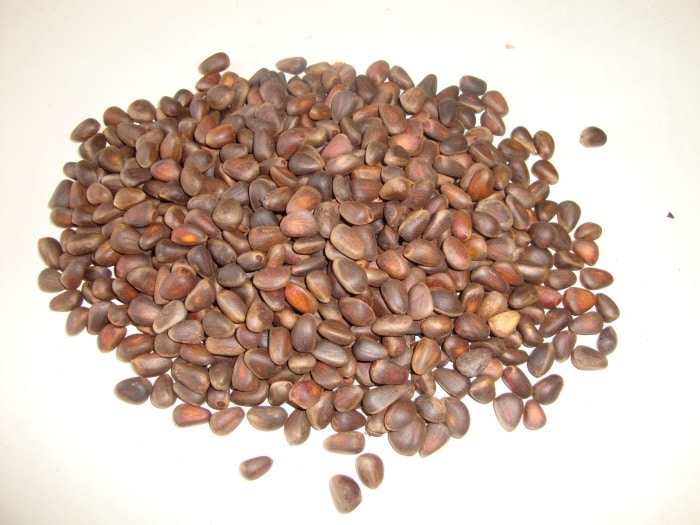
You can grow cedar pine on your site not only from ready-made seedlings, but also from fresh seeds. They are often planted directly in open ground, but many gardeners first germinate them in a pot.
Growing cedar begins with choosing suitable planting material. Only high-quality seeds produce shoots. When selecting nuts for planting, pay attention to:
- Weight. The nuts should be quite heavy. Seeds that are too light are empty.
- Appearance. The shell color should be a uniform dark brown. There should be no green or light spots, mold, chips, growths, dents or other damage. The seeds should be smooth, with a shape characteristic of cedar fruits.
- Age. The greatest similarity is found in seeds less than a year old. If the nuts are more than 2 years old, their germination rate is reduced by 2 times. In the 3rd year, the chances that the seeds will germinate are minimal.
It is best to collect the seeds yourself. Cones lying on the ground are usually affected by mold, fungal infections, and rodents.That's why they are collected from the tree. The optimal time for this is October and November.
Important! It is not recommended to buy nuts in the store or at the market. There is a possibility that they are more than a year old or were stored incorrectly, which negatively affects germination.
Before growing cedar from a nut, prepare planting material:
- Remove all damaged, moldy specimens with stains. The largest ones are selected.
- Nuts are immersed in a solution prepared from 1 tsp. salt and 1 tbsp. water. After half an hour, the seeds that have sunk to the bottom are removed and washed. Those that float are thrown away as they will not rise.
- Prepare a light pink solution of potassium permanganate and soak the nuts in it for 2 hours. Then rinse in clean water at room temperature.
Seeds for planting are taken 2-3 times more than the required number of seedlings. Pine nuts have a relatively low germination rate.
To get seeds from a cone, it is left for a while near a radiator or quickly scorched with fire. This will help the scales open.
Stratification
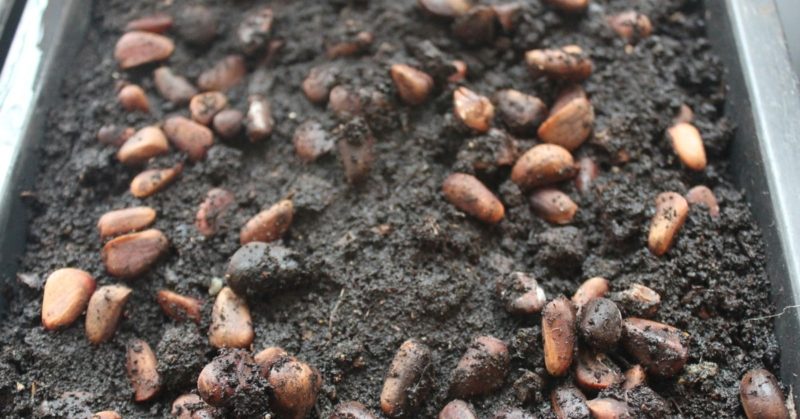
Stratification is an important stage in cedar germination. Under natural conditions, it goes away on its own. Seeds that fall to the ground remain in the ground until spring. A gradual change in temperature and frost harden the planting material and prepare it for germination.
Self-stratification:
- Take a wide but shallow box and fill it with soil. The substrate must be treated with a dark pink solution of potassium permanganate.
- Seeds are planted in prepared soil to a depth of 1-2 cm. Water generously with water at room temperature. All soil should become moist.
- Lay out a layer of snow 5–7 cm thick. Cover the box with the plantings with film and put it in the refrigerator, but not in the freezer.
- As the soil dries, moisten it, preferably with melt water.
Stratification should last at least 3 months. All this time, the seeds are kept on the bottom shelf of the refrigerator or in the cellar.
Soil preparation and container selection
The soil is bought in a specialized store or prepared independently.
The following mixtures are suitable:
- equal amounts of river white sand, gravel chips, peat;
- peat from a coniferous forest mixed with garden soil in equal proportions;
- sawdust, garden soil, peat and sand in equal proportions.
The resulting soil is disinfected: calcined in the oven or spilled with a dark pink solution of potassium permanganate, boiling water or a solution prepared from a bucket of water and 3 tbsp. l. copper sulfate.
Be sure to use drainage: shell rock, expanded clay, small crushed stone, broken ceramics. It is also disinfected.
It is better to plant seeds in one large container, as many of them will not germinate. It is convenient to use a wide but shallow container with a height of 10 cm. Later, the seeds will have to be planted in individual, fairly deep containers.
The planting container is also disinfected: doused with boiling water, wiped with alcohol or soaked in a dark pink solution of potassium permanganate or a solution prepared from 3 liters of water and 1 tbsp. l. copper sulfate.
Planting and germination of pine nuts at home
After 3 months of stratification, they begin to sow seeds. They can be planted directly in open ground or grown at home.
Advice! Seeds are planted in open ground in the fall. In this case, they will undergo natural stratification.
Various seating options
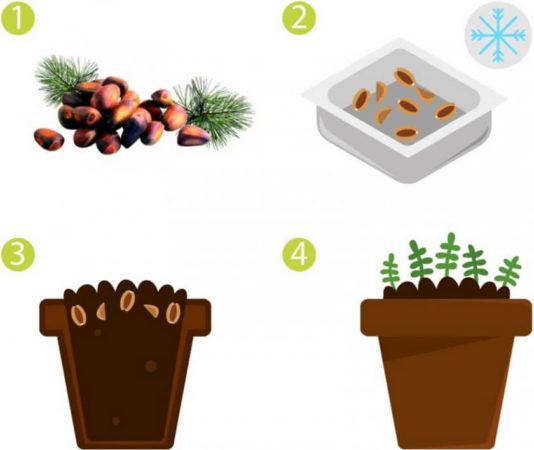
One of the simplest options for germinating pine nuts involves using a substrate in which the planting material has undergone stratification.In this case, the box with seeds is taken out of the refrigerator or cellar, watered generously with warm water and placed in a warm and bright place. The container is covered with film and left in this form until the seeds germinate. The film is periodically opened slightly for ventilation. The soil is moistened as it dries.
The disadvantage of this method is that seeds that are not tested after stratification may be infected with a fungus. In this case, most of the planting material will not germinate.
Most gardeners prefer to replant nuts in new soil:
- The seeds are taken out of the ground in which they were stratified and sorted. Remove specimens that are covered with mold, have stains, traces of rot, or soft areas.
- The nuts are washed in a light pink solution of potassium permanganate and dried.
- 1-2 cm of drainage is poured into the bottom of the planting container. The rest of the volume is filled with soil so that 2-3 cm remain free to the edge.
- Seeds are planted in the soil to a depth of 0.5–1 cm. The distance between them should be at least 3 cm. Planting material cannot be planted deeper, otherwise it will germinate slowly.
- The soil is moistened with water at room temperature. The container is covered with film or transparent glass and placed in a warm and bright place.
- As the soil dries, moisten it, preferably with melt water. The soil should be saturated with moisture, but the liquid should not stand above the surface of the soil.
It takes an average of 1.5–3 weeks to germinate seeds after stratification. Some gardeners plant nuts directly in individual containers, but this method is uneconomical, since the cedar seed material has low germination.
Caring for seedlings before transplanting to a permanent location
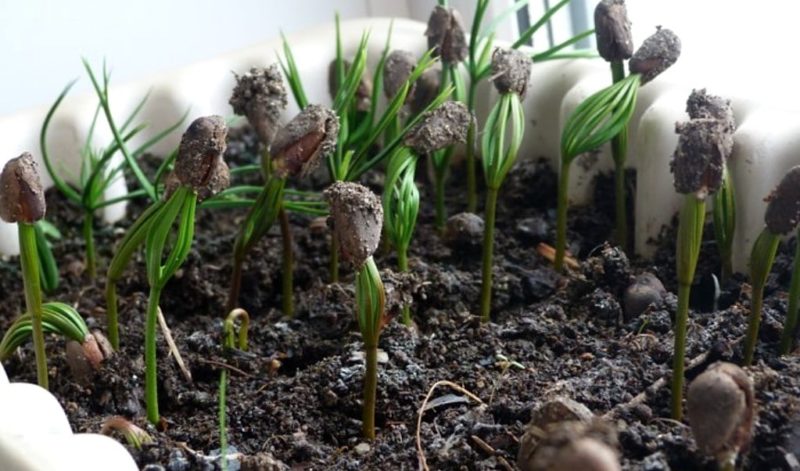
In order for the seedlings to be strong and viable, it is important to properly care for them:
- The seedlings are kept in a place with a temperature of +20…+22°C. Plants should receive enough sunlight, but be protected from direct rays.
- The sprouts are watered as the soil dries with melted or settled water. It is important that it does not stagnate.
- When the height of the sprouts reaches 3 cm, they are transplanted into individual containers. The optimal height of the container is 15 cm. 5 cm of drainage is poured into the bottom of the pot. The rest of the volume is filled with soil. The soil is watered abundantly. The cedars are carefully dug out from the common box, trying not to damage the root system, and transferred to pots. The depth should be such that the root collar is above the surface of the earth.
- After transplantation, the plants are protected from direct sunlight for the first 2 weeks. Fertilizers are not used.
- Pots with established transplanted cedars are taken out onto the street or balcony. First for 15 minutes, then the time is increased, gradually increasing to a day. Next, the pots are left outside to harden the plants.
- Seedlings are grown in pots throughout the year. Therefore, it is important to provide them with proper wintering. In the cold season, cedars are taken to cool rooms. The optimal temperature is 0°C.
Read also:
Hazelnuts - benefits and harm for women
Eating walnuts for weight loss: is it possible to eat and in what quantity?
Rules for transplanting seedlings into open ground
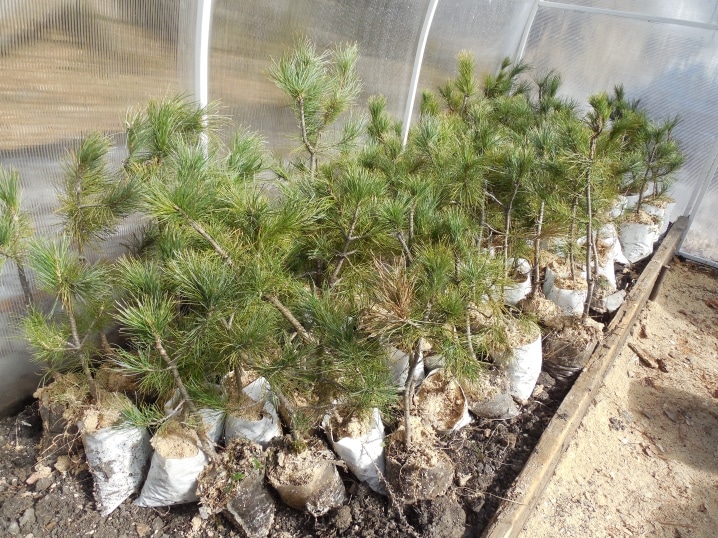
Cedar pine is planted in a permanent place a year after planting. By this time it will get stronger, harden, and take root. Planting work is carried out in the spring, when the soil warms up.
Cedars feel best in their natural growing environment: in Siberia and the Urals.However, they are also planted in central regions, for example, in the Moscow region, St. Petersburg, etc. In cities with a southern climate, the crop is not grown in open ground. Too high temperatures prevent it from developing correctly.
Attention! Cedars are also grown at home, in large pots.
For plants, choose a semi-shaded area. You can plant them near bushes, which will protect the seedlings from the scorching rays of the sun.
The soil should not be saline. The optimal occurrence of groundwater is no closer than 1.5 m to the surface.
Before planting, plants in pots are watered and fed with an infusion of ash or a humus solution. Instructions for transplanting into garden soil:
- For cedars, holes are dug with a diameter and depth of 70 cm. The distance from the plant to other trees is at least 3 m.
- A drainage layer of at least 10 cm is poured onto the bottom of the hole. Expanded clay, broken ceramics, small crushed stone, and cones are suitable.
- The soil removed from the hole is mixed with sand and peat. Take 1 part of these ingredients for 2 parts of land.
- Part of the nutrient soil mixture is poured to the bottom. The seedling is carefully transferred to the planting hole along with a lump of earth. The free space is filled with soil without deepening the root collar.
- The plants are watered. For each use 4 liters of water.
- The tree trunk circle is mulched with humus or spruce branches. Layer thickness is within 20–25 cm.
Mycelium to increase survival rate
In order for the cedar to take root faster and feel comfortable, mushrooms that are in symbiosis with the plant are planted in the tree trunk circle. Only those mushrooms that grow in coniferous forests are suitable.
The mycelium is brought from the forest or bought in a specialized store. The soil around the tree is simply mixed with mushroom material.
Read also:
Is it possible to eat almonds on a weight loss diet?
Aftercare
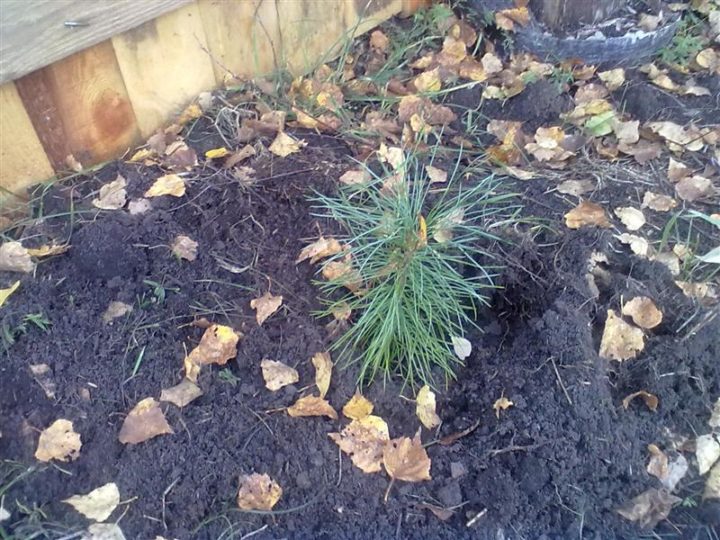
Cedar requires minimal care:
- Watering. Plants are watered once a week. Use settled water. The older the plant, the more liquid is used to hydrate it.
- Feeding. Contributed 2 times a year. In spring, 60 g of potassium nitrate is used for each tree, and in autumn - 50 g of superphosphate.
Conclusion
It is possible to grow cedar from seeds at home. In this case, it is important to carry out stratification, provide the plants with suitable conditions and proper care. However, it is believed that nuts planted directly in open ground produce hardier trees.